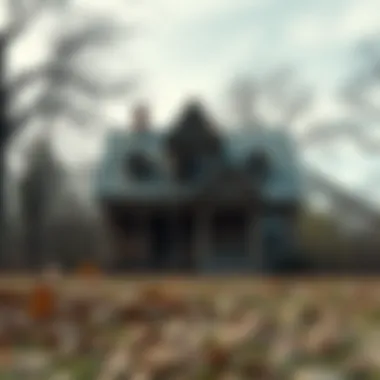Understanding Zombie Foreclosures: Causes and Effects


Intro
Zombie foreclosure is a term that captures a rather unsettling aspect of the real estate landscape. It arises when a homeowner moves out of their property and stops making mortgage payments, yet the property remains tied to an active foreclosure process. This can lead to a host of complications for neighborhoods, investors, and the housing market at large. For those caught in the throes of such a situation, the implications can be devastating. In this guide, we will delve into the intricacies of zombie foreclosures, exploring their causes, consequences, and potential solutions.
Definition of Key Terms
To fully grasp the concept of zombie foreclosure, it's vital to understand several key terms related to the phenomenon.
Explanation of Important Financial Concepts
- Deficiency Judgment: This occurs when a lender pursues the remaining balance owed on a mortgage after a foreclosure sale. If the home sells for less than the mortgage amount, the homeowner could still owe money.
- Short Sale: A sale where property sells for less than the amount owed on the mortgage. This process is often used by homeowners trying to avoid foreclosure.
- Non-Judicial Foreclosure: A process where the lender forecloses on a property without court involvement. Many states allow this as a quicker and less expensive route for lenders.
Industry Jargon and Acronyms
- REO (Real Estate Owned): Properties that have completed foreclosure process and are owned by the lender.
- HUD (Housing and Urban Development): A government agency that oversees various housing programs, including those aimed at homeownership.
"Understanding the key terms is the first step in navigating the complexities of zombie foreclosures. The more informed you are, the better decisions you can make."
Glossary of Terms
Here’s a concise alphabetical list of relevant terms, each accompanied by a brief definition to facilitate smoother reading through the article.
- Abandonment: The act of leaving a property without intention of returning, which can lead to a zombie foreclosure situation.
- Foreclosure: The legal process by which a lender takes possession of a property after the borrower fails to meet the mortgage repayments.
- Market Value: The price at which a property would sell under current market conditions.
- Lien: A legal right or interest that a lender has in a borrower's property, granted until the debt obligation is satisfied.
Having a grasp of these terms will not only assist in understanding the issue at hand but can provide clarity when making strategic decisions.
For a deeper dive into these concepts, resources like Investopedia and Bankrate can be particularly helpful.
As we move further into the discussion on zombie foreclosures, understanding these definitions and terms will aid homeowners and investors alike in navigating this challenging landscape.
Prelims to Zombie Foreclosure
Zombie foreclosure is a term that not many household names outside of real estate circles are familiar with, yet it holds significant weight in the current economic climate. This phenomenon encapsulates a unique intersection of emotional distress, urban decay, and economic pitfalls. As homeowners abandon their properties while still grappling with outstanding mortgage debt, they unwittingly contribute to a broader issue affecting their neighborhoods and the housing market at large. Understanding the nuances surrounding zombie foreclosure is key for both distressed homeowners and potential investors aiming for informed decision-making in real estate ventures.
The importance of discussing this topic lies in its multifaceted implications. Foreclosures can shake the foundation of communities, eroding property values and fostering environments ripe for crime and desolation. For investors, knowledge about these properties can potentially unlock opportunities in the distressed real estate market, allowing for profitable investments. However, navigating these waters requires a nuanced understanding of local laws, property conditions, and market trends. Thus, in this exploration, we will delve into the definition of zombie foreclosure, its historical context, the causes behind it, and the subsequent effects it has on property values and neighborhoods at large.
Defining Zombie Foreclosure
Zombie foreclosure is characterized by the abandonment of a property by its owner while still being liable for the mortgage associated with it. In many cases, homeowners may have received a notice of default and ceased mortgage payments, effectively throwing in the towel without formally completing the foreclosure process. Such properties sit vacant, often becoming the eyesores of neighborhoods, much to the detriment of local communities. These homes are often perceived as "dead" in the eyes of the owners but are still very much alive in the legal sense, hence the term zombie foreclosure.
The underlying reasons for reaching a state of zombie foreclosure can be varied. Homeowners may experience significant financial strain, prompting feelings of hopelessness and confusion regarding the path forward. Often, securing well-informed guidance can be an uphill battle, leading some to abandon hope entirely.
Historical Context of Foreclosure Trends
To truly grasp the implications of zombie foreclosure, one must look into the historical trajectory of foreclosure trends. The surge in foreclosures experienced during the housing market crash of 2008 is a glaring case in point. Startling reports from various agencies detailed skyrocketing foreclosure rates as the economy fell into a recession. Many homeowners found themselves underwater, meaning they owed more on their mortgages than the market value of their homes. When the dust settled, a subclass of properties began to emerge—abandoned homes left in limbo, still tethered to lingering mortgage obligations.
As foreclosure rates peaked, states scrambled to impose new regulations and improve their processes to handle the fallout. Areas particularly hard-hit began to experience a wave of properties characterized by neglect, dilapidation, and blighted landscapes. Notably, urban centers like Detroit witnessed stark examples of this trend, where entire neighborhoods fell victim to this complex cocktail of abandonment and financial miscalculation.
Through this lens, individuals can better grasp the complex and sometimes chaotic nature of the real estate market, especially under stress. A clear understanding of zombie foreclosure also paves the way for better policy discussions regarding homeowners’ rights, property investment opportunities, and overall market health.
The Causes of Zombie Foreclosure
Understanding the roots of zombie foreclosure is crucial for both homeowners and investors. Identifying the factors that lead to these abandoned properties can shine a light on why they occur and potentially pave the way for effective solutions. When homeowners walk away from their debts, it does not just impact them; the aftershocks can be felt throughout local communities, affecting property values and neighborhood safety. Through examining the multifaceted reasons that contribute to zombie foreclosures, we not only grasp the broader implications of this phenomenon but also equip ourselves with knowledge to address it.
Economic Factors Contributing to Abandonment


Diving into the economic landscape, several elements come into play. One of the primary culprits is the economic downturn, as evidenced during the 2008 financial crisis. Homeowners in precarious financial situations may find themselves unable to keep up with mortgage payments. When jobs disappear or income shrinks, the likelihood of abandonment increases. The American economy has witnessed fluctuations that left many individuals drowning in debt, while their homes' values plummeted.
For instance, during economic slumps, properties can lose significant value. This sometimes prompts owners to make a tough choice: continue sinking money into a home that's losing value or cut their losses and abandon it. Some homeowners may also realize that the market has shifted so much that they owe more than their home is worth, leading them to view surrender as a viable option.
Another economic factor is the rising costs associated with homeownership. Property taxes, maintenance fees, and insurance can pile up, to a point where homeowners feel overwhelmed. When these costs exceed their capacity, especially against a backdrop of stagnant wages, abandonment can seem like the best option. High unemployment rates and a lack of affordable housing alternatives only compound these issues, exacerbating the incidence of zombie foreclosures.
Psychological Impacts on Homeowners
The mental toll on homeowners facing foreclosure cannot be overlooked. Psychological factors play a significant role in the decision to abandon a home. When faced with financial strain, individuals often experience increased levels of stress, anxiety, and hopelessness. This emotional burden can cloud judgment, prompting them to disengage from what often feels like an insurmountable problem.
Many homeowners enter a state of denial and avoid confronting the reality of their situation. This psychological paralysis can lead to procrastination in seeking solutions, ultimately resulting in abandonment. The feeling of shame or failure associated with foreclosure can be so profound that some individuals simply choose to walk away, believing it to be less stressful than attempting to manage their obligations.
Moreover, societal factors contribute to these psychological impacts. The stigma attached to foreclosure can isolate homeowners, making them feel as if they are navigating this turbulent sea alone. The lack of support networks might drive them away from seeking assistance until it’s too late.
Legal and Policy Influences
The legal framework surrounding foreclosure significantly influences homeowners’ decisions. A complex and often cumbersome legal process may discourage individuals from pursuing their rights or seeking alternatives. In some jurisdictions, lengthy and confusing foreclosure processes can result in homeowners becoming demoralized and opting to vacate their properties instead of fighting back.
Policy changes, or lack thereof, can also lead to increased rates of zombie foreclosure. If laws do not adequately address the needs of struggling homeowners, they may feel like they have no choice but to abandon ship. Furthermore, local government measures can either alleviate or exacerbate the issue. For example:
- In the wake of a crisis, some areas may have implemented measures like moratoriums on foreclosures or loan modification programs to help homeowners remain in their homes.
- On the flip side, if regulations are too loose or favor banks, homeowners might find themselves facing greater risks without adequate protections.
Understanding these causes is essential for crafting effective solutions and can allow investors and community members to play a constructive role in mitigating the effects of zombie foreclosure. An informed perspective encourages proactive measures aimed at community improvement and homeowner support.
Implications of Zombie Foreclosure
Understanding the implications of zombie foreclosure is crucial, as this phenomenon carries a range of far-reaching consequences, affecting not only individual homeowners but the broader community and market dynamics. In situations where properties are left vacant and unpaid, the ramifications extend into various sectors, posing challenges and opportunities that require attention.
Effects on Property Values
When a homeowner abandons their property during the foreclosure process, it doesn't just leave an unsightly structure on the street; it often leads to an inevitable decline in property values. For instance, consider a suburban neighborhood where one home faces zombie foreclosure. This home, left untended, becomes overgrown with weeds, attracting pests and vandalism. Neighbors who once enjoyed a prized piece of residential real estate may find their property values slipping like a bar of soap in a wet hand.
Several vital factors contribute to this decline:
- Market Perception: Properties in distress often skew market perceptions, signaling to potential buyers that the area is experiencing upheaval. This can fearlessly drive up the rate of vacancies, as buyers skip over homes in these troubled neighborhoods.
- Compounded Issues: As foreclosures accumulate, local governments generally face increased maintenance costs for public land, which can lead to higher taxes or fees for residents. Such fiscal stress can diminish the attractiveness of the neighborhood further.
"A single abandoned home can cast a long shadow, affecting not just its immediate vicinity, but an entire community’s reputation."
- Comparative Sales: In real estate, comparables play a crucial role in determining value. When comparables are undersold due to foreclosure, neighboring homes get dragged down by association, leading to a widespread depreciation of property values.
This spiral doesn’t just stop with lowered prices; it can restrict financing options for existing homeowners, thwarting attempts to refinance or sell due to decreased equity. With homeowner equity in retreat, the neighborhood faces an uphill battle in revitalization efforts.
Impact on Neighborhood Dynamics
Zombie foreclosures reshape the neighborhood dynamics in more ways than one. The physical presence of abandoned properties can create a mental toll on communities. As homeownership embodies a stake in the community, the abandonment of properties can foster feelings of insecurity and neglect. Homeowners who witness their neighbors walking away may hesitate to invest in renovations, fearing that their financial ventures will yield little return. This ka-nocker effect can lead to a general atmosphere of despair.
Factors to keep in mind regarding neighborhood relations include:
- Social Cohesion: When properties fall into abandonment, the social fabric of neighborhoods can fray. Residents might feel isolated and disconnected from their once-thriving community.
- Crime Rates: Vacant properties can become hotbeds for criminal activity, creating an environment of fear and declining safety. This can compel longtime residents to leave, further deteriorating the neighborhood's community structure.
- Community Investment: Fear and uncertainty can lead to reduced investment in local businesses and community programs. As prospective buyers and investors shy away, the local economic activity can slump, creating a vicious cycle that becomes difficult to reverse.
In summary, the implications of zombie foreclosure cut deep, affecting property values and altering neighborhood dynamics. With understanding, communities can better prepare to combat these issues, whether that’s through investing in revitalization efforts or advocating for policies aimed at encouraging responsible homeownership and timely foreclosure processes. Finding a way to break the cycle is essential for fostering resilient neighborhoods that can withstand the impacts of the unfortunate reality of zombie foreclosures.
Navigating Virus and Foreclosure Laws
The landscape of foreclosure is complex enough as it is, but the advent of recent health crises—like the COVID-19 pandemic—has introduced a slew of unique challenges and considerations for homeowners and investors alike. Understanding the interplay between public health responses and foreclosure laws is paramount for navigating this intricate terrain effectively. With various state-specific regulations in play, understanding your rights and responsibilities is more important than ever.


State-Specific Foreclosure Regulations
Foreclosure laws vary significantly from one state to another. In the wake of the pandemic, many states temporarily suspended foreclosures or offered deferments to provide struggling homeowners breathing room. However, these regulations are often short-lived, and their true parameters can be muddled. For instance, while some states enacted blanket moratoriums that froze all foreclosures, others created a patchwork of protections, leaving homeowners unsure of their stance.
Here are a few examples of how different states reacted:
- California: Introduced various programs, including the COVID-19 Rent Relief program. This helped to stave off eviction and foreclosure for many.
- New York: Imposed a moratorium that lasts until foreclosures could be processed in a manner deemed safe.
- Texas: While foreclosures continued, the state mandated a more extended notice period, giving homeowners more time to seek assistance.
But knowing the local rules does not stop there; homeowners should also look into small print details and additional resources available through state websites or community agencies to know fully how these laws may affect them. The nuances — like deadlines for applications or specific documentation needed — can significantly influence outcomes.
Rights of Homeowners During Foreclosure
One critical aspect often overlooked is the rights of homeowners throughout the foreclosure process. Many folks assume that once the process begins, they are at the mercy of the system. This is not the case. Homeowners possess several rights designed to protect them, such as the ability to challenge the foreclosure in court, the right to know the details of the foreclosure, and, in some states, the right to redeem their property post-sale.
Moreover, there are always options for negotiating with lenders. For individuals navigating the treacherous waters of foreclosure, options may include:
- Loan Modification: Contacting lenders to explore restructuring existing mortgage terms.
- Forbearance: Requesting that the lender temporarily reduce or suspend payments.
- Deed in Lieu of Foreclosure: Transferring the property back to the lender instead of going through the lengthy foreclosure process.
It’s crucial for homeowners to seek assistance and familiarize themselves with their rights. Ignorance isn’t bliss but a ticket to loss.
"In many scenarios, homeownership can feel like a noose around your neck, but understanding your rights can help you breathe easier, even in tough times."
Investor Considerations
When discussing zombie foreclosures, the conversation often pivots towards investors—those looking to capitalize on properties that have been left in limbo by distressed homeowners. Understanding this particular aspect is crucial for both novice and seasoned investors who seek to navigate the murky waters of the real estate marketplace. Here, we will explore key elements that define investor considerations in the realm of zombie properties, detailing the benefits, risks, and evaluations essential for making informed decisions.
Identifying Zombie Properties
Identifying zombie properties requires more than just a casual glance at neighborhood listings. Investors need to develop a keen eye for spotting potential opportunities that others might overlook. Properties left in a state of abandonment often exhibit telltale signs. For instance, investors should look for homes with overgrown lawns, boarded-up windows, and maintenance neglect. Additional resources such as county tax records and foreclosure notices can provide essential information, helping investors locate these hidden gems.
"Zombie properties are the ghosts of what once was—identifying them is key to reaping rewards."
To assist in the identification process, here are several strategies:
- Consult local property records to uncover homes that have been in foreclosure for an extended period.
- Leverage various online platforms like Zillow or RealtyTrac, which provide listings of distressed properties.
- Engage with local real estate agents who specialize in distressed properties. Their expertise can be invaluable.
- Attend foreclosure auctions; even if you don’t bid, observe unbiddable properties and their condition for future consideration.
Evaluating Investment Risks
Before diving headfirst into the world of zombie properties, it’s vitally important to evaluate potential investment risks. The allure of cheap properties can lead to impulsive decisions, so a cautious approach is warranted. Investors must consider the following risks:
- Legal Complications: Properties burdened with unresolved liens or complicated title issues may pose significant hurdles. Researching the property’s legal history is essential.
- Repair and Restoration Costs: Many zombie properties require extensive work. Accurate estimates for necessary renovations should be made to avoid financial pitfalls.
- Market Fluctuations: Investing in areas marked by declining property values can wreak havoc on potential returns. Conduct market analysis diligently to ascertain future growth potential.
- Community Reputation: Abandoned homes can affect nearby property values and the overall neighborhood appeal. Assess how community dynamics could influence future investment potential.
To mitigate these risks, employ due diligence and consider the following strategies:
- Conduct thorough research on prevailing market conditions and forecast trends.
- Assemble a reliable team, including real estate attorneys, contractors, and local agents, to help navigate complexities.
- Create a comprehensive budget that includes not only the purchase price but also projected repairs and ongoing maintenance costs.
Strategies and Solutions
Navigating the treacherous waters of zombie foreclosures requires a multi-faceted approach that encompasses a deep understanding of the available strategies and solutions. It’s not just about recognizing the signs of impending abandonment; it’s equally about knowing how to counteract them effectively. By addressing both psychological and structural components of foreclosure, homeowners can enhance their chances of retaining ownership or, at the very least, mitigate the financial damage.
Misconceptions About Foreclosure Assistance
A common myth surrounding foreclosure assistance is that all help is created equal. Many homeowners mistakenly believe that government programs or non-profit organizations offer a one-size-fits-all solution. This is far from the truth. While various initiatives exist, not all of them are designed to cater to individual circumstances. Reaching out to different resources is critical. Local housing authorities or community action agencies can provide tailored guidance that aligns with the specific situations of distressed homeowners.
Additionally, there’s a significant misrepresentation about the immediacy of relief. People often assume that contacting a foreclosure assistance program will immediately halt legal proceedings, but this rarely happens without navigating a procedural maze.


"Understanding your unique financial condition is pivotal in discerning which resources can best serve you, rather than relying on general information that may not suit your needs."
Foreclosure Prevention Programs
Foreclosure prevention programs are a beacon of hope for many facing the harsh realities of financial distress. These programs often include options such as loan modifications, hardship assistance, and even mediation services designed to negotiate better repayment terms. For instance, the U.S. Department of Housing and Urban Development (HUD) provides tools and counseling to help homeowners avoid the pitfalls that could lead to foreclosure.
One should also keep an eye on state-specific initiatives, as local governments may have unique programs addressing challenges unique to their populations. Addressing financial difficulties early can leverage these programs effectively, so procrastinating would only diminish those options. Programs such as the Home Affordable Modification Program (HAMP) provide avenues to adjust mortgage payments so they’re more manageable, enabling families to stay in their homes rather than becoming yet another zombie foreclosure statistic.
Restoration of Abandoned Properties
Restoration of abandoned properties is not a simple task, yet it can breathe new life into communities plagued by zombie foreclosures. One pivotal strategy involves engaging local governments or community organizations to tackle the issue collectively. These groups can facilitate initiatives that repair and rehabilitate neglected properties, ultimately increasing neighborhood stability.
Homeowners looking to restore their properties can consider connecting with programs that offer funding for renovations. Various non-profits exist, such as Rebuilding Together, and local grants may also be available. The restoration not only benefits the individual homeowner but also uplifts the local economy by reinstating property values and attracting potential buyers.
In summary, these strategies and solutions are essential for addressing the increasingly pressing issue of zombie foreclosure. Recognizing pervasive misconceptions, seeking targeted prevention programs, and investing in the restoration of abandoned properties can pave a path toward healthier neighborhoods and more secure homes. Through these efforts, homeowners and investors alike can navigate this minefield more effectively and contribute to the revival of their communities.
Long-term Outlook for Zombie Foreclosure
Examining the long-term outlook for zombie foreclosure is crucial for both homeowners and investors. The fate of these abandoned properties can significantly affect real estate markets and community dynamics. Understanding this topic involves several intricate elements that intertwine economic conditions, local housing demand, and potential future legal changes. Moreover, being aware of the implications can empower stakeholders to make informed decisions and strategize accordingly.
One pivotal consideration is how trends in the real estate market will impact zombie foreclosures. As housing demand continues to fluctuate, properties that fall into the zombie category may either gain or lose value. For example, in areas where housing prices are on the rise, foreclosures could become opportunities for investors looking to buy low and sell high, assuming they can mitigate the risks associated with these problematic properties.
On the flip side, if a market sees a downturn, the prevalence of zombie housing could amplify. Properties left in limbo often degrade, exacerbating neighborhood issues and reducing local property values further. It’s not just about the individual home; it’s about the broader patterns emerging from these situations. Insight into market trends helps in anticipating these shifts, which is beneficial both for individual investors and for communities.
Trends in the Real Estate Market
Keeping abreast of trends in the real estate market provides essential context for understanding zombie foreclosure dynamics. A growing trend in remote work, for instance, has influenced where people choose to live. Many individuals are leaving urban centers, seeking affordability and space in suburban or rural settings. This shift can lead to an increase in abandoned properties in areas previously deemed unstable, as homeowners may abandon their urban homes in hopes of finding better deals elsewhere.
Additionally, rising housing costs and insufficient affordable housing options lead many to fall behind on their mortgage payments, shifting more properties into a zombie state. Key factors to consider include:
- Economic conditions: Interest rates, employment rates, and wage growth will significantly influence housing demand and foreclosure rates.
- Demographic shifts: Changes in the population, such as millennials entering the market or the aging baby boomer population, will alter housing needs and values.
- Investment patterns: Real estate investors, particularly institutional investors, are increasingly influencing market dynamics, often taking on distressed properties.
These patterns tell a tale of caution; while some areas might see a resurgence, others may plunge into deeper difficulties, leading to an uptick in zombie properties along the way.
Potential Policy Changes
Policy changes play a vital role in shaping the trajectory of zombie foreclosures. Laws that govern foreclosure processes and homeowner protections are often subject to change based on political climates and public opinion. For instance, states that have implemented more stringent regulations on foreclosure can improve outcomes for struggling homeowners, thereby reducing the zombie inventory over time.
Key potential changes to monitor include:
- Increased homeowner protections: Legislation aimed at providing more support to homeowners facing foreclosure could curb the number of zombie properties. Situations such as extended grace periods or mediation requirements between lenders and distressed homeowners can bring relief.
- Tighter lending criteria: As lenders adjust their policies following economic changes, this can impact how and when homes enter foreclosure. Stricter credit requirements may reduce mortgage approvals, yet could inadvertently leave some homeowners in precarious positions if they cannot secure financing.
- Local government initiatives: Many local governments are recognizing the importance of maintaining community stability and may introduce incentives for homeowners to stay or investors to revitalize abandoned properties.
Recognizing potential policy shifts ensures that stakeholders remain vigilant and adaptable in the face of evolving regulations. A proactive approach to understanding these factors allows both homeowners and investors to better navigate the complexities that come with zombie foreclosure.
In sum, the long-term outlook for zombie foreclosure revolves around market trends, changing demographics, and potential policy shifts. Staying informed can make a world of difference for anyone impacted by this issue.
Culmination
The conclusion serves as a crucial element in summarizing the findings and implications relating to zombie foreclosure. This section encapsulates the core themes explored within the article, providing a holistic view that draws together various components of zombie foreclosure, from its underlying causes to the ramifications on both properties and communities.
Summarizing Key Insights
As we navigate through the intricate landscape of zombie foreclosures, several key insights emerge:
- Abandonment Trends: Many homeowners find themselves in a space where they emotionally detach from their properties, leading to a significant increase in abandoned homes.
- Market Impact: These abandoned properties often contribute to declining property values within an area, overwhelming neighborhoods with issues like vandalism and reduced appeal.
- Legal Frameworks: Different states have varied regulations regarding the foreclosure process, which can further complicate a homeowner's situation and their rights.
- Investor Opportunities: For savvy investors, there are usually opportunities to purchase these distressed properties at lower prices, but due diligence is paramount to avoid potential pitfalls.
In gathering these insights, individuals can not only better understand their own situations but also recognize the broader economic forces at play that can lead to zombie foreclosure scenarios, equipping themselves to make informed decisions.
Final Thoughts on Zombie Foreclosures
The phenomenon of zombie foreclosures is more than a mere statistic; it reflects deeper social and economic challenges impacting many homeowners and the communities they reside within. As we step forward, addressing these issues requires not only enhanced awareness but also proactive engagement by homeowners, policymakers, and investors alike. The complexities surrounding zombie foreclosure highlight the necessity for legal reforms, comprehensive prevention programs, and investments aimed at restoration rather than neglect.
"Knowledge is not power; it is only potential power. It becomes power when, and only when, it is organized into definite plans of action and directed to a definite end." – Earl Nightingale















